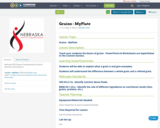
Nebraska FCS Classes: Fundamentals of Foods & Nutrition and Culinary 1
- Subject:
- Career and Technical Education
- Education
- Material Type:
- Activity/Lab
- Lesson
- Lesson Plan
- Date Added:
- 07/10/2019

Nebraska FCS Classes: Fundamentals of Foods & Nutrition and Culinary 1
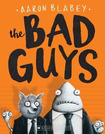
This lesson is strictly to have students find a love for reading. Many times we just give them books and make them read them, but if we can incooperate a series that is popular and urge them to go to the library, they might catch on that there are millions of books and they will like some of them. This would work for 5-6 grade students and is based on "The Bad Guys" series.
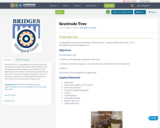
Gratitude Tree
A Copyrighted Activity Re-Posted with Permission from Gretchen Miller MA, ATR-BC, CTC-S www.gretchenmiller.wordpress.com
Objectives:
The participants will:
1. Reflect on the blessings they have in their lives
2. Create art elements using line, color and symmetry with nature as their inspiration
Audience:
This activity can be enjoyed by all age groups.
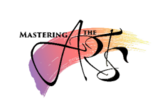
This resource was created by Kim Francis in collaboration with Lynn Bowder as part of ESU2's Mastering the Arts project. This project is a four year initiative focused on integrating arts into the core curriculum through teacher education and experiential learning.
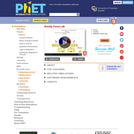
Visualize the gravitational force that two objects exert on each other. Change properties of the objects in order to see how it changes the gravity force.
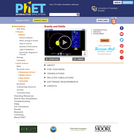
Move the sun, earth, moon and space station to see how it affects their gravitational forces and orbital paths. Visualize the sizes and distances between different heavenly bodies, and turn off gravity to see what would happen without it!
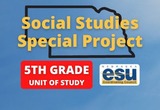
Was Great Britain dependent on trade with the colonies? This inquiry will guide students through the impacts trade had on both Great Britain, the colonists and other countries during the late 1700’s. In this inquiry students will research and draw conclusions on how trading impacts relationships and dependency between countries. Resource created by Barbara Knopik, Centura Public Schools, as part of the Nebraska ESUCC Social Studies Special Projects 2024 - Inquiry Design Model (IDM).
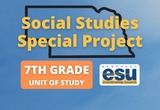
Which empire is most superior? Students will be stepping into the shoes of a historian, uncovering the histories and cultures of three major civilizations. Students will work in teams to investigate both the breadth and depth of various aspects of their societies including the geography and natural resources available to each, their social structures, and their expansion to determine the superiority of the empires. Students will analyze information, debate with peers, and use critical thinking skills to draw independent conclusions. Resource created by Kimberly West, Millard Public Schools, as part of the Nebraska ESUCC Social Studies Special Projects 2024 - Inquiry Design Model (IDM).

The Great Escape
By: Caleb Kowalsk Copyright 2018 by Caleb Kowalsk under Creative Commons Non-Commercial License. Individuals and organizations may copy, reproduce, distribute, and perform this work and alter or remix this work for non-commercial purposes only.

Explore how the Earth's atmosphere affects the energy balance between incoming and outgoing radiation. Using an interactive model, adjust realistic parameters such as how many clouds are present or how much carbon dioxide is in the air, and watch how these factors affect the global temperature.
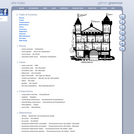
Grimm Grammar is an online German grammar reference from the University of Texas at Austin. It is an irreverent revival and shameless exploitation of 19th-century Grimm Fairy Tales for honorable pedagogical purposes.

Students use gumdrops and toothpicks to make lithium atom models. Using these models, they investigate the makeup of atoms, including their relative size. Students are then asked to form molecules out of atoms, much in the same way they constructed atoms out of the particles that atoms are made of. Students also practice adding and subtracting electrons from an atom and determining the overall charges on atoms.
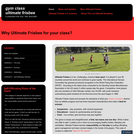
Ultimate Frisbee is simple and straightforward: a field, two teams and one disc. While it takes very little to start, it yields a lot in return by encouraging healthy bodies, lifestyles and mentalities. Ultimate Frisbee teaches responsibility and fair-play by putting officiating, game management and team conduct largely in the hands of its players. Ultimate Frisbee promotes a culture of valuing all of its members and being inclusive by gender, race/ethnicity and levels of mental and physical ability. It builds cohesion among diverse players and forms a community. It’s a safe, non-contact sport where girls and boys may play together even at the highest levels.
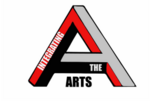
This resource was created by Terresa Greenleaf, in collaboration with Dawn DeTurk, Hannah Blomstedt, and Julie Albrecht, as part of ESU2's Integrating the Arts project. This project is a four year initiative focused on integrating arts into the core curriculum through teacher education, practice, and coaching.
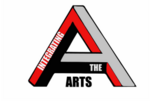
This resource was created by Sandy Schneider, in collaboration with Dawn DeTurk, Hannah Blomstedt, and Julie Albrecht, as part of ESU2's Integrating the Arts project. This project is a four year initiative focused on integrating arts into the core curriculum through teacher education, practice, and coaching.
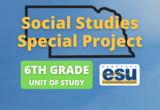
In this inquiry project, students will determine whether they believe Hammurabi’s Code of Laws is fair or not. They will research who Hammurabi was and his role in Babylonia, discover the differences in social classes in the region at the time, and analyze the laws as they apply to different social groups. Resource created by Elizabeth Dunn, Nebraska City Public Schools, as part of the Nebraska ESUCC Social Studies Special Projects 2022 - Inquiry Design Model (IDM).
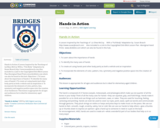
Hands in Action
A Lesson Inspired by the Teachings of Liz Shea-McCoy With a “Full-Body” Adaptation by Susan Brasch http://www.susanjbrasch.com Also included is a Link to the Copyrighted Dick Blick Lesson Plan Aboriginal Hand Prints www.dickblick.com which can also be found in this hub.
Objectives:
1. To Learn about the importance of hands
2. To identify the many uses of hands
3. To create art using hands (and other body parts) as both a vehicle and an inspiration
4. To incorporate the elements of color, pattern, line, symmetry and negative positive space into the creation of art
Audiences:
This lesson is appropriate for all ages and audiences but is ideal for elementary-aged children.

This lesson will help students learn proper handwashing techniques.
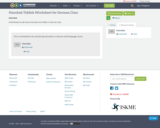
A Worksheet to talk about Hanukah and Yiddish in German class.

This lesson provides an overview of common health insurance plans. This lesson will also introduce how health insurance processes can sometimes impact patient care. This lesson is best complemented with a guest speaker from an area hospital, ask for an individual who works in billing and insurance. StandardsHS.HS.8.2.b Compare types of health care insurance, including private, managed care, and government programs